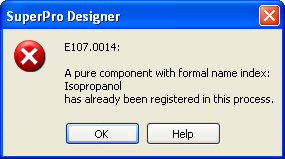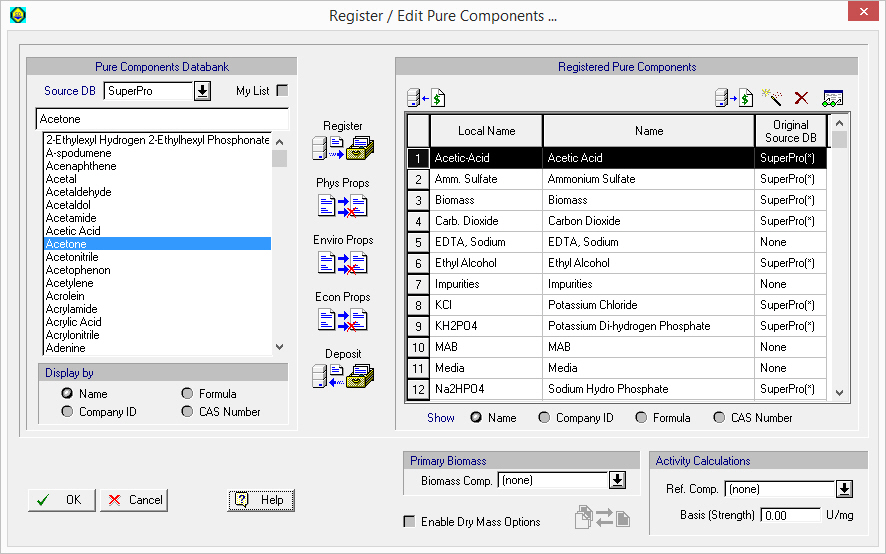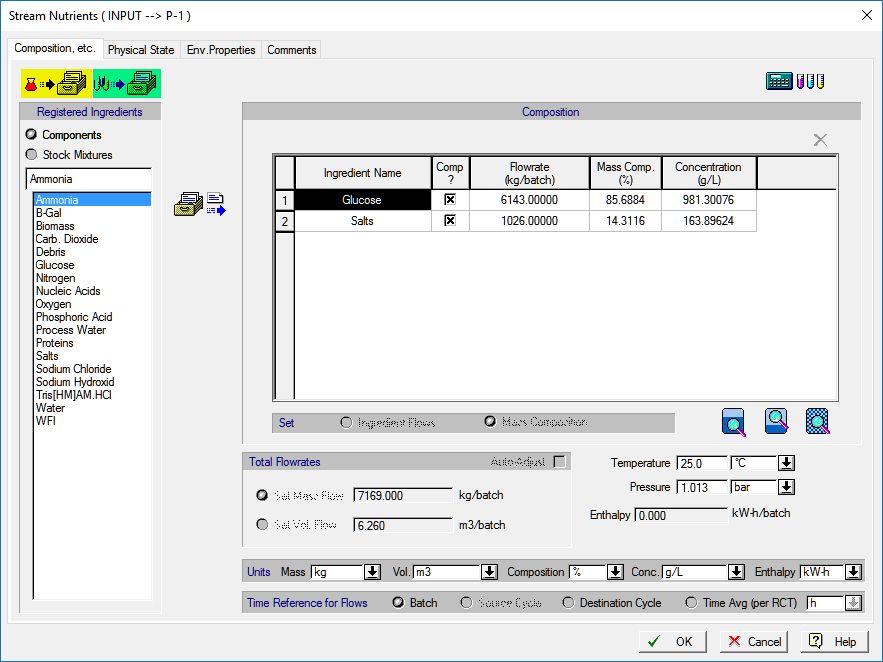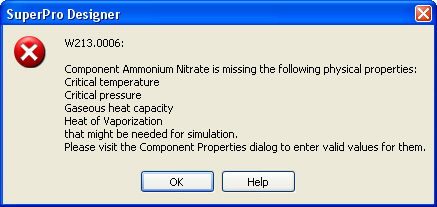Pure Component Registration
Before you are able to use a material in your process as a pure component, you must define:
1. Its physical properties (molecular weight, density, heat capacity, critical properties, etc.)
2. A name tag by which this component will be known to the rest of the process elements (streams, operations, etc.). Since formal names (represented by the ‘Name’ property) tend to be very long, SuperPro Designer lets you define a shorter name tag (called the ‘Local Name’) for each component present in your process. Every component’s ‘Name’ and ‘Local Name’ must be unique within your process.
Instead of having to describe each component’s properties from scratch, you can use one of SuperPro Designer’s component databanks as a source to pull components into your process simulation (with their property values already defined); for more details, see Pure Components Databank. If you cannot find the component that you need in the databanks you can introduce a new (your own) component. When starting a new process simulation, probably one of the first actions that you take is to introduce the components that will participate in the process. It is not necessary to provide an exhaustive list at the very beginning, because the members of the component-registry in a process file can be modified at any time. However, as good practice, it is recommended that as soon as you start a new simulation project, you should introduce (register) as many of the components that will be present as early as possible, as of most of the initialization parameters in streams and operations depend on the list of components present in the process (e.g., stream composition, component separation factors, key design components, etc.). If you add components after having initialized such operations, default values will be provided for the newly introduced components but you may be forced to revisit the i/o simulation dialog of the affected operations anyway.
To introduce (register) a component into your process, select the } } option from the main menu (or type Ctrl+2 as a shortcut). Then, the Pure Component Registration Dialog appears. Components for a process can either be imported from the component databank or can be defined from scratch just for the needs of your specific simulation. When using the component databank as a source, component data will be pulled from one of the following database sources:
● The ‘SuperPro (User)’ database
● The ‘DIPPR’ database
● The ‘PPDS’ database
For more details, see Pure Components Databank.
If you wish to pull a pure component from the databank, you must first choose the desired database source at the top left of the Pure Component Registration Dialog. Once you have selected a database as a source, the list box below will be filled with the contents of the selected database. The components in the databank are indexed and can be listed in one of four ways:
|
Component Indices
(for ‘SuperPro’ Databank)
|
Name (up to 31 char.)
Trade Name (up to 31 char.)
Chemical Abstract Service (CAS) Number (up to 15 char.)
Local Name (up to 15 char.)
|
|
Component Indices
(for ‘DIPPR’ Databank)
|
Name
Chemical Abstract Service (CAS) Name
Chemical Abstract Service (CAS) Number
IUPAC Name
|
|
Component Indices
(for ‘PPDS’ Databank)
|
Name
Trade Name (Aspen Name in PPDS)
Formula
Chemical Abstract Service (CAS) Number
|
For some chemicals in the ‘SuperPro’ database, no CAS numbers could be found (or it didn’t exist). Such chemicals are given made-up CAS numbers that are very easy to recognize: “N/A xxxx”. The ‘Local Name’ is simply a shorter version of the full name of a chemical or it could represent a alias by which a chemical is known to the members of your organization. In any case, the ‘Local Name’ is the name by which a registered component will identify itself to the user in i/o simulation dialogs of operations and streams, reports, etc. and thus it becomes the ‘ID-Tag’ by which a component is known to the process. Therefore, the application will not allow you to register two components (or mixtures) with the same ‘Local Name’.
|

|
Sometimes it is necessary to have the same chemical substance (e.g. NaCl) represent two different forms of that substance (e.g. in soluble form and as a crystal). After you have registered NaCl as a component for the first time (to represent the soluble form), you cannot re-register NaCl. If you did you would receive the following message:
To get around the fact that the application requires all registered components to have a unique (formal) ‘Name’ and ‘Local Name’, you should define a ‘new’ component on the New Component Definition Dialog with a ‘Name’ of “Sodium Chloride Crystals” using ‘Sodium Chloride’ as the starting component. Then, introduce that component into the process (using a different ‘Local Name’ - e.g. “NaCl-Cryst”) and use it to represent the NaCl crystals.
|
In fact, the application will not allow you to register a component whose ‘Local Name’ or ‘Name’ clashes with any of the already registered components and mixtures. Note that the same restrictions apply when you attempt to register a stock mixture (see Stock Mixture Registration). This restriction is necessary as commonly users have to choose an ingredient from either a component or a mixture list (e.g., when initializing the composition of an input stream). If two different ingredients were allowed to have the same name, or local name, then it would be impossible to know which one is selected.
Name conflicts are checked without regard to lower or upper case. In that sense, “Ethanol” will be considered the same name as “ETHANOL” or “ethanol”. The reason is different sources (databases) of component information may include the same component with slightly different spelling (when it comes to letter case).
|

|
When copying-and-pasting parts of one simulation into another, all component-related information (e.g. retention factors in a filtration operation) are carried over. In order to make sure the information is carried over properly, the application will compare the component registry of the target (receiving) document, and if some components are missing, they will be automatically registered. Also, if some components are considered ‘the same’ they will be substituted by the ones pre-existing in the receiving document. In cases of components whose “Formal Name” or “Local Name” differs only up to letter case, then the actual spelling of the component (or mixture) as-is in the receiving document will be retained.
|
Sometimes you may need to register a component for the needs of your current simulation but you can’t find it listed in any of the component databanks. At this point, you have two options:
a) Introduce the new component in the user databank first (see Adding and Deleting Pure Components); then pull it from the ‘SuperPro (User)’ database into your process simulation using the Pure Component Registration Dialog. This may seem like a long, two-step procedure, but if you follow this approach, then the newly introduced component will have a presence in the ‘SuperPro (User)’ database, and it will always be readily available to be used for the needs of any future simulations.
b) Introduce the new component directly in your process simulation from the Pure Component Registration Dialog. This option is useful if you don’t have good values for all the properties of the component at this time, or if you don’t think that any other future simulations may benefit from that component or if you simply don’t have any write-authorization to the ‘SuperPro (User)’ database. Of course, if you change your mind later and decide to keep the component in the ‘SuperPro (User)’ database, you can always do it from the same dialog.
|

|
The ‘Designer’ and ‘DIPPR’ databases contain equivalent data when it comes to estimating physical properties of pure components. However, the ‘Designer’ database also contains more data (economic properties & environmental properties) for each of its component record. The extra data are used when performing economic calculations and environmental assessments. Such data (purchase price, BOD, COD factors, etc.) are not available in the DIPPR database. If you imported a component originally from the ‘DIPPR’ or the ‘PPDS’ database, it will have default (mostly zero) values for all such properties. It is up to the user to edit those missing values (see To edit the properties of a registered pure component...) or, if possible, to find the equivalent or similar component in the ‘SuperPro (User)’ database and copy its non-DIPPR data (see To copy only a subset of component properties....)
|
Pure Component Registration Dialog
This dialog appears when you select } } from the main menu of the application.
The component registration dialog.
Using this dialog you can:
● Introduce (add or register) a component into the process by importing it from a pure component databank (see Pure Components Databank).
● Introduce (add or register) an altogether new pure component (which does not exist in any of the pure component databanks).
● View and/or edit the properties of a registered component (see Pure Component Properties Dialog).
● Delete a component that is already registered in your process.
● Deposit a pure component already present (registered) in your process into the ‘SuperPro (User)’ database. This is important if you have introduced a component directly into your process and later have decided to keep the component and its properties as part of your component databank for future reuse.
● Transfer (copy) physical, economic or environmental property data (as kept in the records of the ‘SuperPro (User)’ database) from a member of the component databank onto an already registered component that either lacks such data or has outdated data. This is especially useful when the registered component originated from the ‘DIPPR’ or ‘PPDS’ databases which lacks economic and environmental data.
● Reconcile (or synchronize) the property values of a registered pure component with its values in the databank (requires that the component has a databank record). You may decide to update the registered component’s data using the databank record values or vice versa (update the databank property values from the values of the component in a process).
● Activate the “Dry Solid” options in this process model, by checking the “Define Dry Mass Components” check box.
● Designate the ‘special component’ of ‘Primary Biomass’ (applies only to biochemical processes, see Special Components.)
● Designate the ‘Activity-Reference’ component and specify the activity basis factor (see Special Components).
|

|
The second column on the registered pure components table shows by default the formal Name of the component. The user may select to display the Company ID, Formula or CAS Number instead by choosing the respective radio buttons located under the table.
|
|

|
The ‘Source’ column on the registered pure components table shows the original source of the pure component’s property values. This may be a database (Designer, User, DIPPR or PPDS) or set by the user as a locally defined component (Local). The asterisk (*) shown next to the database name in parenthesis, indicates that the pure component’s properties are not identical to the properties of the original component in its source database (if it wasn’t ‘Local’). This may happen if the component’s properties have been modified in the process model since its original introduction. If the component was drawn originally from the User DB, it is also possible that the component’s properties may have been updated in the source database. You can choose to update a component’s properties by visiting the dialog under } } You can also choose to do the reverse, i.e., update a component’s properties in the database by visiting the } } The negative sign next to a component’s source database (-) means that the component can not be found at all in its original source database. This may occur if you are viewing a model from someone else, who has a completely different User DB than yours. Or, if the component was drawn from your User DB and by now, you or someone else in your organization deleted the component from the User DB.
|
1. Select the source database
From the database selection list box, select the source database. Typically there is only one option available to users: ‘SuperPro (User)’. If you have purchased and installed ‘DIPPR’ (in its relational database format), then it will exist as the third choice. The ‘PPDS’ may also appear in the list if you have a licensed copy of the PPDS Thermodynamic Property Suite. As soon as you select a source database, its component contents will appear in the list box underneath.
2. Select a component from the available listing
From the databank contents list box, select the chemical that you want to introduce in the process. If the ‘Name’ (or ‘Local Name’ or ‘Trade Name’ or ‘CAS Number’) is not visible, you may scroll up or down until you locate it, or start typing the first few characters of its name at the edit control above the list box. Notice that as you type the interface responds by automatically scrolling in order to bring the first entry that matches the typed portion of the ‘Name’ (or ‘Local Name’ or ‘Trade Name’ or ‘CAS Number’) at the top of the visible list. You may list the contents of the pure component databank by any of the available four indices: ‘Name’, ‘Trade Name’, ‘CAS Number’ or ‘Local Name’.
3. Click on the Register button

As soon as you click on the Register button, the number of rows in the registration table shown on the right, will expand by one (the component order may change as components are listed alphabetically based on their ‘Local Name’).
4. You can repeat the above steps (1 through 3) to introduce more components. When you are finished introducing component, exit the Pure Component Registration Dialog with OK.
1. Click on the  button
button
Fill in the fields of the New Component Definition Dialog that comes up. Even though only uniqueness of names within the process file will be enforced, it is recommended that you use unique strings across the whole ‘SuperPro (User)’ database for the ‘Name’, ‘Trade Name’, ‘CAS Number’ and ‘Local Name’, in case you decide later to keep the component as a permanent member of the databank.
2. Specify a source component to be used for property value initialization
You must use another component as source for initializing the new component’s property values. The source component can be part of the list already registered in your process or it can reside in a pure component databank.
3. Click OK
Unless the program detects any conflicts in the name definitions, (all strings except the ‘Formula’ must be unique within the list of registered components) the new component will be added to the list of registered components.
4. If you need to introduce more components this way, repeat steps 1 through 3, and when you are finished adding components, exit the Pure Component Registration Dialog with OK.
|

|
The list of registered components presented is alphabetical (based on the ‘Local Name’). That is the same order that components are presented when one needs to choose say the “Design Component” in an operation, or to supply all component related information in operations (like, the “Rejection Coefficient” in an Ultrafiltration operation).
|
5. Components in a process start to appear either through the initialization of a process input stream, or when a component appears to be the product of a reaction. To facilitate the introduction of a component (or a mixture) during the initialization of an input stream, users can click on the button (highlighted with yellow below) shown on the i/o input stream dialog (see below). The green highlighted button will bring up the Mixture Registration dialog (described elsewhere). After a new component (or mixture is added), it will become immediately available in the list of component ready to be included in the composition list of that input stream.
|

|
Occasionally pure components and/or stock mixtures may appear in your registration list without you explicitly introducing them. This may happen if you copy-and-paste into your model one or more unit procedures and/or streams from another process model. In order to properly carry over component-related information, SuperPro Designer will silently expand your list of components and mixtures to make sure it includes all components referenced in the pasted objects. Components (or mixtures) with the same formal name are assumed to be the same and their identity in the pasted data is assumed by the component (or mixture) in the destination model. If a component in the pasted data does not exist (based on its formal name) in the destination model, it is automatically introduced. If any of its other index-names (trade name, local name, CAS, company ID) is already taken by another component, the conflicting index value is changed (silently) by adding a “1”, “2”,... etc. till it becomes unique. The same applies for stock mixtures. If the stock mixture (based on its formal name) doesn’t exist, it is silently introduced; if any of its other index-names (trade name, local name, company ID) conflict with existing stock mixtures, it is also (automatically) changed by adding “1”, “2”... etc. till it no longer conflicts.
|
Clicking on the button shown above will invoke the same Component (or Mixture) Registration dialog mentioned previously,
|

|
In the ‘Designer’ component databank, few components don’t have values for some of their properties. If you attempt to register such a component you will see the following message:
The application will still accept the registration of this component, but you must make sure that its missing property values are properly specified before this component is involved in the simulation of an operation whose model requires it. If you don’t, then the operation’s model will issue a warning when you attempt to execute the M&E balances.
|
1. Select the component in the registration table
Locate the component in the registration table and click on the row that represents the component. Notice that when you click on it, the whole row is highlighted.
2. Click on the  button.
button.
The Pure Component Properties dialog appears with all the properties of the selected component ready to be viewed and/or edited.
3. To keep the changes you made on the selected component’s properties, exit the Pure Component Properties Dialog by clicking on OK. The changes are still not permanent. They will become permanent when you exit the Pure Component Registration Dialog by clicking OK. If you don’t exit the Pure Component Registration Dialog with OK but by clicking Cancel, any component property modifications you made will be lost.
|

|
Modifying the properties of a registered component that was pulled from a component databank does not affect the property values of the original component record in the databank. It will also not affect the component properties of the same component used in simulations by others sharing the same component databank(s) with you.
|
1. Select the component in the registration table
Locate the component in the registration table and click on the row that represents the component. Notice that when you click on it, the whole row is highlighted.
2. Click on the Delete the  button.
button.
1. Select the component in the registration table
Locate the component in the registration table, and click on the row that represent the component. Notice that when you click on it, the whole row is highlighted.
2. Click on the Deposit button

If the component does not exist in the ‘SuperPro (User)’ database currently, it will be added. If the component already exists in the database, the program will request a further confirmation that indeed the intention is to update the existing component’s properties in the databank. In any future project that you may need to import that component from the databank, the component will have the newly assigned set of values.
|

|
Please remember that any changes in the ‘SuperPro (User)’ database as a result of any action on this dialog will be permanent and will not be reverted even if you exit the Pure Component Registration Dialog with Cancel.
|
Sometimes you may need to copy only a subset of properties from one component onto another. This situation will often arise when you have registered a component that was originally pulled from the ‘DIPPR’ or ‘PPDS’ databases. Since these databases not keep the full set of a SuperPro Designer component properties (e.g. purchase price, BOD content, COD content, etc.), when such a component is originally registered, by default, all these properties are initialized to zero. You could visit the Pure Component Properties dialog and edit those values yourself. SuperPro Designer offers you another choice. If you find the same (or a similar) component in the ‘SuperPro (User)’ database, you can copy all the non-physical property values from that component with just a click of button (see below).
1. Select the target component in the registration table.
Locate the component in the registration table, and click on the row that represent the component. Notice that when you click on it, the whole row is highlighted.
2. Select a component database.
Select one of the available component databases to display its contents.
3. Select the source component.
From the contents of the selected database, select the component you wish to use as the source of the component properties.
4. Click on Phys Props, Enviro Props or Econ Props button
Depending on the button you chose, the corresponding set of properties will be copied from the source component (in the databank) onto the target component (in your process file). Notice that the Enviro Prop and Econ Prop buttons are not available if the source component resides in the ‘DIPPR’ or ‘PPDS’ database because this repository of property data does not include such properties.
1. Select a registered pure component which currently exists in the ‘SuperPro (User)’ database. In order for a component to be verified as ‘existing’ in the ‘SuperPro (User)’ database, its ‘Name’ must match exactly with one of the records in that database.
2. Click on the  button to update the economic properties of the registered pure component from the record in the ‘SuperPro (User)’ database.
button to update the economic properties of the registered pure component from the record in the ‘SuperPro (User)’ database.
3. Click on the  button to update the economic properties of the component record in the ‘SuperPro (User)’ database based on the current values of the registered component. Please remember that any changes in the ‘SuperPro (User)’ database as a result of this action will be permanent and will not be reverted even if you exit the registration dialog with Cancel.
button to update the economic properties of the component record in the ‘SuperPro (User)’ database based on the current values of the registered component. Please remember that any changes in the ‘SuperPro (User)’ database as a result of this action will be permanent and will not be reverted even if you exit the registration dialog with Cancel.
![]()



 button
button


 button.
button.

